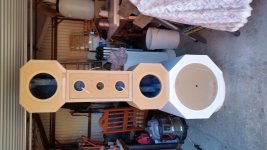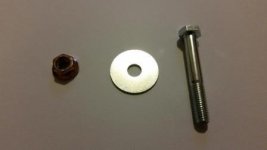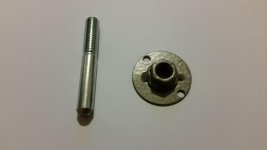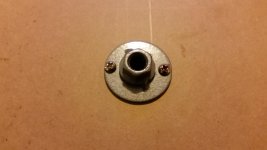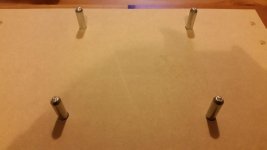As path difference increases between the two drivers and the microphone, the two waves will become more and more out of phase. In the situation of two drivers being close-coupled, the path difference is assumed to be small enough such that the drivers are in phase with each other at the mic position, leading to a full +3 or +6 dB depending on total voltage/VD. When the two drivers are not close-coupled, the size of the spatial envelope (the "sphere") centered at the mic point where the drivers are considered to be in phase can be so small that in practice, the drivers are out of phase. If the waves are 180 degrees out, then forget about summation, you'll hear nothing.Have you ever measured it? I have, the first probably 30 years ago, just to confirm
the theory.
The reason why 2 drivers, driven with equal power (2X power in, or +3dB) produce an
increase of 6 dB in SPL is because the volume displaced (VD or vd(t) ) doubles. VD is
analogous to voltage, double the voltage in a circuit and the power increases by 6 dB.
Look up the equations for SPL calculated as a function of vd(t) and perhaps you will
understand this better.
Why does this happen? The efficiency goes up.
Mutual coupling that you hint at, is not the dominant effect, there are AES papers on this.
It may contribute a small fraction of a dB.
Let me know if I have something wrong here.
You are right.I don't believe that you have ever measured this..........
As path difference increases between the two drivers and the microphone, the two waves will become more and more out of phase. In the situation of two drivers being close-coupled, the path difference is assumed to be small enough such that the drivers are in phase with each other at the mic position, leading to a full +3 or +6 dB depending on total voltage/VD. When the two drivers are not close-coupled, the size of the spatial envelope (the "sphere") centered at the mic point where the drivers are considered to be in phase can be so small that in practice, the drivers are out of phase.
This statement is not wrong but it lacks some accuracy. The factor wavelength may not be forgotten. For larger wavelengths (= lower frequencies) the spatial envelope is much larger than for higher frequencies. So for large MTMs like they are being discussed here the "bubble" at low frequencies will always be quite large.
Because the two drivers in question almost never hit the same room modes, their radiated SPL will often not be the same and therefore the 6dB rule might not always fully apply. But this is not a disadvantage. It helps reducing the effects of room modes.
Regards
Charles
Absolutely. It is much easier to get the reinforcement with lower frequencies than higher frequencies as the longer wavelengths are easier to keep in phase, relative to any given path difference.This statement is not wrong but it lacks some accuracy. The factor wavelength may not be forgotten. For larger wavelengths (= lower frequencies) the spatial envelope is much larger than for higher frequencies. So for large MTMs like they are being discussed here the "bubble" at low frequencies will always be quite large.
Because the two drivers in question almost never hit the same room modes, their radiated SPL will often not be the same and therefore the 6dB rule might not always fully apply. But this is not a disadvantage. It helps reducing the effects of room modes.
Regards
Charles
=========THIS===============Im lost.
DUNLAVY WAS A SPEAKER GENIUS!
Build one large low diffraction cabinet like PBN KAS-2 to reduce vibration and share woofer volume. CNC the complex beveled baffle.
Use SB Acoustics (1", 5", 8", 12" ) 7-speaker set WMmTmMW =$673
------
1" dome tweeter R3=3.2 92.5db LR4@1700Hz to balance: manage lobing; max tweeter power
sb26stcn-04 @$33
-LR4@1700Hz to balance: manage lobing; and max tweeter power
-----------
5" midrange. Re=5.7 88db sealed
sb15nrx30-08 @$56 *2 = $112
-LR4@1700Hz and LR4@400Hz for easy max power
----------
8" woofer. Re= 5.6-ohms 88.5db sealed
sb23nrx45-08 @$92 *2 = $184
-----------
12" woofer. Re=4.2-ohms 90db
sb34nrx75-6 @$172 * 2 = $344
------
purchase two miniDSP 2x4 HD
---Digital inputs, USB streaming, advanced plug-ins
Purchase suitable amplifiers
===============OR===THIS============
GEDDES CONTROLLED DIRECTIVITY IS BETTER SCIENCE!
Study the Geddes paper, and Red Spade audio in Australia.
horn tweeter
or
horn mid+tweet
plus
a couple support speakers like in early pictures
Attachments
micki...
--If you continue to work on a Dunlavy inspired PBN KAS-2 clone, I attached a quick Xsim of the SB-Acoustics MmTmM drivers just to illustrate the SPL balance of this driver combination. The baffle diffraction blip on the SPL plot is partially due to the simple baffle simulation tool/model I used. The PBN engineers were very smart when they used a smooth circular arc shaped bevel around the MmTmM instead of the trapezoid shaped bevel cuts allowed in the simulator. A passive crossover for this MmTmM on a PBN KAS-2 copied baffle, plus a plate amp with a built in LR4 crossover for the pair of 12" woofers should sound decent until 4-amps + DSP perfection is completed.
Dunlavy vs. Geddes Directivity
If you are now considering smaller cabinets.
https://www.pinterest.com/localhifishop/tweek-geeks-bmf-speaker-in-the-making/
My next build uses a horn tweeter to control directivity from 20kHz --> 1.3kHz.
Goal: Build a low diffraction variation of the BMF-1 cabinet construction.
-Tweet = Faital HF108 driver on PRV WG35-25-B waveguide
-Midbass = sealed Acoustic Elegance TD12M
-Woofs = side-side pair sealed Acoustic Elegance TD15S
Passive TM crossover, with active analog Xover between TM and woofs.
Plan is to experiment with black high density fiberboard for the thick stacked baffle required for 3" radius edges.
--If you continue to work on a Dunlavy inspired PBN KAS-2 clone, I attached a quick Xsim of the SB-Acoustics MmTmM drivers just to illustrate the SPL balance of this driver combination. The baffle diffraction blip on the SPL plot is partially due to the simple baffle simulation tool/model I used. The PBN engineers were very smart when they used a smooth circular arc shaped bevel around the MmTmM instead of the trapezoid shaped bevel cuts allowed in the simulator. A passive crossover for this MmTmM on a PBN KAS-2 copied baffle, plus a plate amp with a built in LR4 crossover for the pair of 12" woofers should sound decent until 4-amps + DSP perfection is completed.
Dunlavy vs. Geddes Directivity
If you are now considering smaller cabinets.
https://www.pinterest.com/localhifishop/tweek-geeks-bmf-speaker-in-the-making/
My next build uses a horn tweeter to control directivity from 20kHz --> 1.3kHz.
Goal: Build a low diffraction variation of the BMF-1 cabinet construction.
-Tweet = Faital HF108 driver on PRV WG35-25-B waveguide
-Midbass = sealed Acoustic Elegance TD12M
-Woofs = side-side pair sealed Acoustic Elegance TD15S
Passive TM crossover, with active analog Xover between TM and woofs.
Plan is to experiment with black high density fiberboard for the thick stacked baffle required for 3" radius edges.
Attachments
I have insanely large (6 feet, 350 lbs ea.) 4 ways with active crossovers. My drivers are:JBL 2245h x1, Dayton 12" carbon fiber x 2, monsoon planar x 6, Aurum Cantus ribbon x 2. I use a DCX 2496 for the twelves and up and a DIY crossover for the sub. I think it sounds pretty good. I think 2 x DCX 2496 is my next upgrade.
Someone PM'd me for photos. I did get a DCX2496 and love it. My new crossover points are: 12dB/8ve LR low pass on the JBL 2245 Infinite baffle with a custom, standalone electronic crossover. The mains have a high pass at 50 Hz Butterworth 6 dB/8ve. I go from the dual carbon fiber twelves to the six monsoons with a 24 dB LR at 235 HZ, and cross from the six Monsoons to dual ribbons at 1950 Hz with LR 24. I know Aurum Cantus recommends 2.3K or above, but I'm using two with a steep slope so I'm OK. It measures well and sounds extremely good. I use BGW 620b's on everything but tweeters. I have a 25uf Auricap blocker on the ribbons. Right now I'm using a cheap Kenwood on the tweeters but may try a console/diy tube amp in the near future if one comes my way. These actually started out life as VMPS FF1's twenty or so years ago. All that's left is the woofers and the cabinet. The design is based on idea of Brian Cheney's that never made it into production because of lack of demand/parts availability or whatever.
Attachments
Last edited:
Latest update.
Lots of work has been done. Labour of love making speakers. I have had lots of help from diy members offline from here and have made some really great friends in the process, without their help I would never have progressed this far.
Ended up going 4 way-6 drivers with octo baffles for the woofer and bass. All individual enclosures for the woofer, bass and mtm so 4 enclosures for each speaker. ScanSpeak and SB Acoustics.
Construction is 32 and 25mm MDF constrained layer on all enclosures.
As for the crossover, I have purchased the Ultimate Preamp which is the subject of another thread on here. Fully active, 4 amps per speaker, 750w class D stereo for the woofer and bass and 250 class AB stereo for the MTM.
The digital source is Daphile running from a purpose built PC streamer.
They enclosures are being finished now and I will post some pictures when they come back. Woofer and bass units will be semi gloss black and the mtm is a satin black/silver 25%. They look awesome.
Lots of work has been done. Labour of love making speakers. I have had lots of help from diy members offline from here and have made some really great friends in the process, without their help I would never have progressed this far.
Ended up going 4 way-6 drivers with octo baffles for the woofer and bass. All individual enclosures for the woofer, bass and mtm so 4 enclosures for each speaker. ScanSpeak and SB Acoustics.
Construction is 32 and 25mm MDF constrained layer on all enclosures.
As for the crossover, I have purchased the Ultimate Preamp which is the subject of another thread on here. Fully active, 4 amps per speaker, 750w class D stereo for the woofer and bass and 250 class AB stereo for the MTM.
The digital source is Daphile running from a purpose built PC streamer.
They enclosures are being finished now and I will post some pictures when they come back. Woofer and bass units will be semi gloss black and the mtm is a satin black/silver 25%. They look awesome.
Attachments
The enclosures are secured together using the following method.
Started out with a nut, bolt and washer. Chopped the heads off the bolts in the bench drill with the angle grinder and ground a 45deg edge on them. TIG Welded the nut to the washer, drilled 2 holes in the washer. This is a blind nut that will never come off.
Four of these are used on each surface of the bass enclosure as placement guides. There are holes in the woofer and mtm enclosure that line up with these steel pegs. The enclosures are then secured at the rear using the same blind nut method on bass and woofer but with machine head screws. I will post some pictures of that when I get them back from painting.
Started out with a nut, bolt and washer. Chopped the heads off the bolts in the bench drill with the angle grinder and ground a 45deg edge on them. TIG Welded the nut to the washer, drilled 2 holes in the washer. This is a blind nut that will never come off.
Four of these are used on each surface of the bass enclosure as placement guides. There are holes in the woofer and mtm enclosure that line up with these steel pegs. The enclosures are then secured at the rear using the same blind nut method on bass and woofer but with machine head screws. I will post some pictures of that when I get them back from painting.
Attachments
Nice to see how you progressed. Congrats!
I am also considering MTM. What is your crossover frequency between midrange and tweeter, and what is the Center to center distance between midranges? One typical concern is lobbying, which affected by that distance so generally efforts are made to keep it as small as possible.
I am also considering MTM. What is your crossover frequency between midrange and tweeter, and what is the Center to center distance between midranges? One typical concern is lobbying, which affected by that distance so generally efforts are made to keep it as small as possible.
Yes, those two midranges look far too apart.
I am building 4 way (for home, not pa) with hivi planar tweeter, two 2" dayton domes (only $30 each now), two 6" dayton midbass, and 15" woofer (one per side for now).
I have even removed front plates of the domes to be able to mount them closer to tweeter.
My cross fr will be 150, 800, 4k.
Good luck with build.
I am building 4 way (for home, not pa) with hivi planar tweeter, two 2" dayton domes (only $30 each now), two 6" dayton midbass, and 15" woofer (one per side for now).
I have even removed front plates of the domes to be able to mount them closer to tweeter.
My cross fr will be 150, 800, 4k.
Good luck with build.
Thanks guys.
All distances remain true to the original Sovereign's/SC-IV and John Dunlavy's principles of time alignment. I know they look to far apart but they are spot on. As the original drivers were not available substitutions have been made with far superior drivers than were available at the time they were made 1987-2002. Mid to tweeter is 150mm which is only 5mm less than the Sovereign. I have all the original measurements and plans of both sets of speakers and the mid to mid is 310mm.
Good luck with your builds guys.
Are you going active or passive?
All distances remain true to the original Sovereign's/SC-IV and John Dunlavy's principles of time alignment. I know they look to far apart but they are spot on. As the original drivers were not available substitutions have been made with far superior drivers than were available at the time they were made 1987-2002. Mid to tweeter is 150mm which is only 5mm less than the Sovereign. I have all the original measurements and plans of both sets of speakers and the mid to mid is 310mm.
Good luck with your builds guys.
Are you going active or passive?
Last edited:
Thanks guys.
All distances remain true to the original Sovereign's/SC-IV and John Dunlavy's principles of time alignment. I know they look to far apart but they are spot on. As the original drivers were not available substitutions have been made with far superior drivers than were available at the time they were made 1987-2002. Mid to tweeter is 150mm which is only 5mm less than the Sovereign. I have all the original measurements and plans of both sets of speakers and the mid to mid is 310mm.
Good luck with your builds guys.
Are you going active or passive?
What is the crossover frequency M to T?
I'm using the Ultimate Preamp which is also an 8 channel active crossover. Final cover frequency will depend on testing. That's the beauty of active. I don't have to go building swapping soldering passive components and do endless amounts of measuring. I can measure change measure on the fly. So nothing is set in stone.What is the crossover frequency M to T?
I'm using the Ultimate Preamp which is also an 8 channel active crossover. Final cover frequency will depend on testing. That's the beauty of active. I don't have to go building swapping soldering passive components and do endless amounts of measuring. I can measure change measure on the fly. So nothing is set in stone.
Right. I also use active. Nevertheless the physics aren't affected and if your xo frequency is such that the corresponding half of a wavelength is larger than the MTM center to center distance, generally lobbying becomes an issue. Hence all the questions. But you don't seem very interested in hearing that.
To answer your question the crossover point from mid to tweeter is 3khz. I know you are going to say its all wrong and for that xover frequency it should be a distance of 5cm or there abouts. However I am building a clone of the original Duntech Sovereign or Dunlavy SC-IV. And those are the measurements. And thats what I am building. It worked fine in the originals. Point source at 10 feet. There are plenty of articles around that explain John Dunlavy's work.
We’ve spaced drivers like Dunlavy did so plan to listen at 10 ft. Loping will prop be fine from there. These are not “stereo imaging from anywhere in the room” speakers. These are “ I want the best sound possible, right here” speakers. They’ll sound really good from anywhere, but outstanding from one seat. Just like it was mixed down to sound like.
Duntech Sovereign 2001 - Manual - 4-Way Loudspeaker System - HiFi Engine
We’ve spaced drivers like Dunlavy did so plan to listen at 10 ft. Loping will prop be fine from there. These are not “stereo imaging from anywhere in the room” speakers. These are “ I want the best sound possible, right here” speakers. They’ll sound really good from anywhere, but outstanding from one seat. Just like it was mixed down to sound like.
Duntech Sovereign 2001 - Manual - 4-Way Loudspeaker System - HiFi Engine
Last edited:
Right. I also use active. Nevertheless the physics aren't affected and if your xo frequency is such that the corresponding half of a wavelength is larger than the MTM center to center distance, generally lobbying becomes an issue.
It is the inverse actually. If the center to center distance is getting larger than half the wavelength the lobing issues begin. If it were the other way around it would be quite easy to fulfil.
While lobbying can be an issue in politics it is defilitely lobing that is an issue with loudspeakers ! 😉
I run a large MTM that doesn't fulfil D'Appolito's distance requirement either. But it does still profit from the increased vertical directivity at lower frequncies and the fact the lobing is symmetrical (I am experimenting with crossover topologies having improved transient response that are otherwise problematic with TM topologies).
Regards
Charles
- Status
- Not open for further replies.
- Home
- Loudspeakers
- Multi-Way
- Large 4 way using Active Crossovers
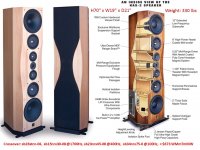

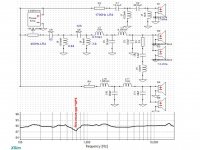
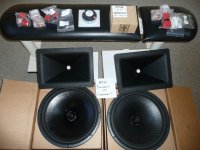
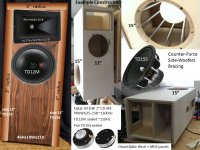
![20170725_114333[1].jpg](/community/data/attachments/566/566134-64542bb820b08ef0c0354208eba053b4.jpg?hash=ZFQruCCwjv)
